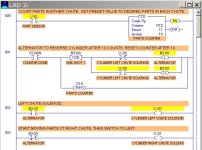HI EVERYONE
I have a double acting cylinder as a diverter.I want to write a program to do the following steps.
Parts are droped in left chute and counted say 50 once 50 parts are done then counter reset to zero at the same time the cylinder is activated and moves to other direction.
Again 50 parts are counted and cylinder is moved to other side and process repeat itself. I need some advice how to go about it, For this project I do not use proxy switch only one cylinder with a solenoid valve having one coil on each side.In addition I also use a external counter and reset pulse given to plc.
Thanks a lot.
I have a double acting cylinder as a diverter.I want to write a program to do the following steps.
Parts are droped in left chute and counted say 50 once 50 parts are done then counter reset to zero at the same time the cylinder is activated and moves to other direction.
Again 50 parts are counted and cylinder is moved to other side and process repeat itself. I need some advice how to go about it, For this project I do not use proxy switch only one cylinder with a solenoid valve having one coil on each side.In addition I also use a external counter and reset pulse given to plc.
Thanks a lot.








